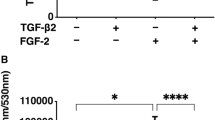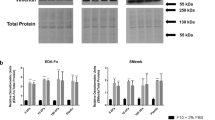Abstract
Peyronie's disease is a fibromatosis of the tunica albuginea. While trauma is believed to be the inciting event, the exact pathophysiology of this condition is unknown. In vitro analysis of cell biology can shed light on the pathogenesis of medical conditions and has been used for many decades as a research tool. We have established a cell culture model, which we have used to study the pathobiology of cells derived from Peyronie's disease plaque tissue. In 10 separate cell cultures derived from different individuals, these cells have demonstrated consistent phenotypic, genotypic and functional alterations. In neither of the control cell cultures, neonatal foreskin fibroblasts and normal tunica-derived fibroblasts have any of the above aberrations been demonstrated. The cells studied have been shown to be fibroblasts in nature with a sub-population of myofibroblasts present in culture. The Peyronie's disease plaque tissue-derived fibroblasts have demonstrated (i) consistent morphologic transformation (ii) increased S-phase on flow cytometry (iii) decreased dependence on culture medium (iv) cytogenic instability (v) excess production of fibrogenic cytokines and (vi) stabilization and dysfunctionalization of p53. Further refinement of this model and future analyses may permit an increased understanding of the pathogenesis of this condition and allow the development of therapeutic strategies.
This is a preview of subscription content, access via your institution
Access options
Subscribe to this journal
Receive 8 print issues and online access
$259.00 per year
only $32.38 per issue
Buy this article
- Purchase on Springer Link
- Instant access to full article PDF
Prices may be subject to local taxes which are calculated during checkout










Similar content being viewed by others
References
Schwarzer U et al. Prevalence of Peyronie's disease: results of an 8000 man survey J Urol 2000 163: 167
Jordan G . Peyronie's disease In: Walsh PC, ed Campbell's urology WB Saunders: Philadelphia 1992 pp 2204–2222
Gelbard MK, Dorey F, James K . The natural history of Peyronie's disease J Urol 1990 144: 1376–1382
Devine CJJ, Somers RD, Lagoda LE . Peyronie's disease: pathophysiology Prog Clin Biol Res 1991 370: 355–358
Devine CJJ, Jordan GH, Somers RD . Peyronie's disease: cause and surgical treatment AUA Today 1989 2: 1–7
Chilton CP, Castle WM, Westwood CA, Pryor JP . Factors associated in the etiology of Peyronie's disease Br J Urol 1982 54: 748–751
Weidner W, Schroeder-Printzen I, Weiske W, Vosshenrich R . Sexual dysfunction in Peyronie's disease: an analysis of 222 patients without previous local plaque therapy J Urol 1997 157: 325–328
Alman RA et al. Aggressive fibromatosis J Pediatr Orthop 1992 12: 1–10
Vande Berg JS, Devine CJ Jr, Horton CE . Mechanisms of calcification in Peyronie's disease J Urol 1982 127: 52–54
Liang SB et al. Tetrasomy 12 in ovarian tumors of the coma-fibroma group: a fluorescence in situ hybridization analysis using paraffin sections Pathol Int 2001 51: 37–42
Ralph DJ, Mirakian R, Pryor JP, Bottazzo GF . The immunological features of Peyronie's disease J Urol 1996 155: 159–162
Devine CJJ, Somers KD, Jordan GH, Scholssberg SM . Proposal: trauma as the cause of Peyronie's lesion J Urol 1997 157: 285–290
Leffell MS et al. Non-association of Peyronie's disease with HLA B7 cross-reactive antigens J Urol 1982 127: 1223–1224
Nachsteim DA, Rearden A . Peyronie's disease is associated with an HLA class II antigen HLA-DQ5, implying an autoimmune etiology J Urol 1996 156: 1330
El-Sakka AI et al. An animal model of Peyronie's-like condition associated with an increase of TGF beta mRNA and protein expression J Urol 1997 158: 2284–2290
Mulhall JP, Thom J, Lubrano T, Shankey TV . Basic fibroblast growth factor expression in Peyronie's disease J Urol 2001 165: 419–423
Yamanaka M et al. Genetic instability in Peyronie's disease J Urol 2001 165: 201
Pierpaoli S et al. Chromosomal instability in Peyronie's disease plaques: preliminary data J Urol 1998 159: 362A
Mulhall JP, Thom J, Lubrano T, Shankey TV . Cytogenetic evidence in support of Peyronie's disease being a tunical field defect process J Urol 2000 163: 747A
Somers KD et al. Cell culture of Peyronie's disease plaque and normal penile tissue J Urol 1982 127: 585–588
Smith BH . Peyronie's disease Am J Clin Path 1966 45: 670–674
Brock G et al. The anatomy of the tunica albuginea in the normal penis and Peyronie's disease J Urol 1997 151: 276–281
Devine CJJ, Angemeir RW . Anatomy of the penis and male perineum AUA Update 1993 12: 1–6
El-Sakka AI et al. Histological and ultrastructural alterations in an animal model of Peyronie's disease Br J Urol 1998 81: 445–452
Vernet D et al. Differentiation phenotype of myofibroblasts from penile tuncia albuginea J Urol 2001 165: 200
Bridge JA et al. Clonal chromosomal abnormalities in desmoid tumors. Implications for histopathogenesis Cancer 1992 69: 430–436
Rudolph R, Vande Berg J . The myofibroblast in Dupuytren's contracture Hand Clin N Am 1991 7: 683–692
Bowser-Riley S, Bain AD, Noble J, Lamb DW . Chromosome abnormalities in Dupuytren's disease Lancet 1975 2: 1282–1283
Mosmann T . Rapid colorimetric assay for cellular growth and survival: application to proliferation and cytotoxicity assays J Immun Methods 1983 65: 55–58
El-Sakka A et al. The effects of colchicine on a Peyronie's-like condition in an animal model J Urol 1999 161: 1980–1983
Levine LA . Treatment of Peyronie's disease with intralesional verapamil injection J Urol 1997 158: 1395–1399
Wegner HE, Andersen R, Knipsel HH, Miller K . Treatment of Peyronie's disease with local interferon-alpha 2b Eur Urol 1995 28: 236–240
Anderson MS, Shankey TV, Lubrano T, Mulhall JP . Inhibition of Peyronie's plaque fibroblast proliferation by biologic agents Int J Impot Res 2000 12: (Suppl 3) S25–31
Cross SM et al. A p53-dependent mouse spindle checkpoint Science 1995 267: 1353–1356
Ioakim-Liossi A et al. p53 Protein expression and oestrogen and progesterone receptor status in invasive ductal breast carcinomas Cytopathology 2001 12: 197–202
Leite KR et al. Abnormal expression of mdm2 in prostate carcinoma Mod Pathol 2001 14: 428–436
Levine AJ . p53, the cellular gatekeeper for growth and division Cell 1997 88: 323–331
Cordon-Cardo C et al. p53 Mutations in human bladder cancer genotypic versus phenotypic patterns Int J Biochem Cell Biol 1994 56: 347–350
Campomenosi P et al. p53 Mutants can often transactivate promoters containing a p21 but not Bax or PIG3 responsive elements Oncogene 2001 20: 3573–3579
Hoos A et al. Characterization of molecular abnormalities in human fibroblastic neoplasms: a model for genotype-phenotype association in soft tissue tumors Cancer Res 2001 61: 3171–3175
Halberg RB et al. Tumorigenesis in the multiple intestinal neoplasia mouse: redundancy of negative regulators and specificity of modifiers Proc Natl Acad Sci USA 2000 97: 3461–3466
Moffatt EJ, Kerns BJ, Madden JM, Layfield LJ . Prognostic factors for fibromatoses: a correlation of proliferation index, estrogen receptor, p53, retinoblastoma, and src gene products and clinical features with outcome J Surg Oncol 1997 65: 117–122
Muller E et al. Molecular genetic and immunohistochemical analysis of the tumor suppressor genes Rb and p53 in palmar and aggressive fibromatosis Diagn Mol Pathol 1996 5: 194–200
Mulhall JP, Branch J, Lubrano T, Shankey TV . Perturbations of cell cycle regulators in Peyronie's disease Int J Impot Res 2001 13: (Suppl 5) S21–S28
Acknowledgements
Experiments outlined in this paper that were conducted at the Andrology Research Laboratory were funded by a Veterans Administration Career Development Award to Dr Mulhall.
Author information
Authors and Affiliations
Rights and permissions
About this article
Cite this article
Mulhall, J., Anderson, M., Lubrano, T. et al. Peyronie's disease cell culture models: phenotypic, genotypic and functional analyses. Int J Impot Res 14, 397–405 (2002). https://doi.org/10.1038/sj.ijir.3900874
Published:
Issue Date:
DOI: https://doi.org/10.1038/sj.ijir.3900874
Keywords
This article is cited by
-
A systematic review of non-surgical management in Peyronieʼs disease
International Journal of Impotence Research (2023)
-
Clinical characteristics and surgical outcomes in men undergoing tunica albuginea plication for congenital penile curvature who present with worsening penile deformity
World Journal of Urology (2020)
-
Nonsurgical management of Peyronie’s disease
Nature Reviews Urology (2019)
-
Surgery for Peyronie's disease
Asian Journal of Andrology (2013)
-
Review of non-surgical treatment options for Peyronie's Disease
International Journal of Impotence Research (2012)



